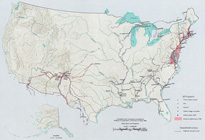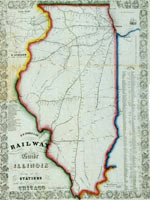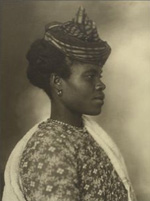Interactions among Europeans and Native Americans varied from place to place, and members of each nation forged relationships with Indians in very different ways, depending on a variety of economic, social and political factors. While we should be mindful of this diversity, we can still make certain generalizations. Few Europeans considered Native Americans their equals, because of differences in religion, agricultural practice, housing, dress, and other characteristics that—to Europeans—indicated Native American inferiority. However, the French, Spanish, and Dutch sought profit through trade and exploitation of New World resources, and they knew that the native people would be important to their success. Europeans also wanted to convert Native Americans to Christianity. Therefore, economic gain and religion were the two factors that most affected the dynamics of European and indigenous American relationships.
The Spanish:
Spain, the most powerful monarchy in Europe and the Americas, wished to enrich themselves with the New World’s natural resources. After enslaving indigenous peoples in the Caribbean and the southern parts of the Americas to grow crops and mine for gold, silver, and other valuables, the Spanish moved into North America where they concentrated their efforts in what is now the southwestern and southeastern United States. In Florida, for example, Spain established a military post at San Augustín, (today called St. Augustine) but only a small number of Spaniards settled there. Catholic missionaries labored to convert the Indians to Christianity, and they experienced some success baptizing and transforming the Guale and Timucuan peoples into farmers. But even the most cooperative Indians continued to maintain their own religious and cultural traditions, and many priests concluded that the Indians were inferior and incapable of understanding Christianity. Indigenous populations declined over the seventeenth century as epidemics brought by the Spanish killed large numbers of natives. San Augustín remained a small outpost throughout the Spanish colonial period; a sort of multicultural crossroads where indigenous peoples came to trade with Spaniards and intermarriage between Spanish men and American Indian women was common.
The French:
Like the Spanish colonies in North America, New France did not attract many French settlers. Instead of enslaving Native Americans in farming and mining operations, the French exploited existing inter-tribal alliances and rivalries to establish trade relationships with the Huron, Montagnais, and Algonquins along the St. Lawrence River and further inland toward the Great Lakes. These Native Americans competed for exclusive status as intermediaries between other Indian traders and the French. Although Native Americans did most of the work, tracking, trapping, and skinning the animals and transporting the pelts to French traders, they drove hard bargains for their furs. French traders exchanged textiles, weapons, and metal goods for the furs of animals such as beavers, bears, and wolves. The trade strengthened traditional clan leaders' positions by allowing them to distribute these trade goods to their clan members as they saw fit. Jesuit (Catholic) missionaries managed to convert considerable numbers of Huron because the priests learned the local languages and exhibited bravery in the face of danger. French officials offered additional incentive for conversion by allowing Christian Hurons to purchase French muskets. In the eighteenth century, the Dutch and English competed with the French for trade and territory, which gave local Indians continued economic, diplomatic, and military leverage as Europeans competed for their trade and military alliances through the seventeenth century.
The Dutch:
Unlike the French and Spanish, the Dutch did not emphasize religious conversion in their relationships with Native Americans. Instead, they focused on trade with American Indians in present-day New York and New Jersey. They established a fur trade alliance with the Iroquois confederacy, the most powerful Native American empire in 17th-century North America. Although smallpox and other European diseases drastically reduced the Iroquois population, the confederation remained strong because they negotiated an advantageous alliance with the Dutch. Dutch weapons helped the Iroquois to defeat the Huron, who were leaders of the other major pan-Indian confederacy in the area.
Native Americans:
As often as possible, Native Americans took advantage of rivalries among European powers to maintain or enhance their own political and economic positions. Wars between England and the Netherlands spilled into North America, and in 1664 during the Second Anglo-Dutch War, England seized control over New Netherland and renamed the colony New York. The Iroquois quickly signed an alliance and trade treaty with the English. However, they also maintained friendly relations with the French and welcomed Jesuit missionaries into their midst. The Iroquois were generally successful at playing the French and English off one another until the English drove the French out of North America at the end of the French and Indian War (1763).



